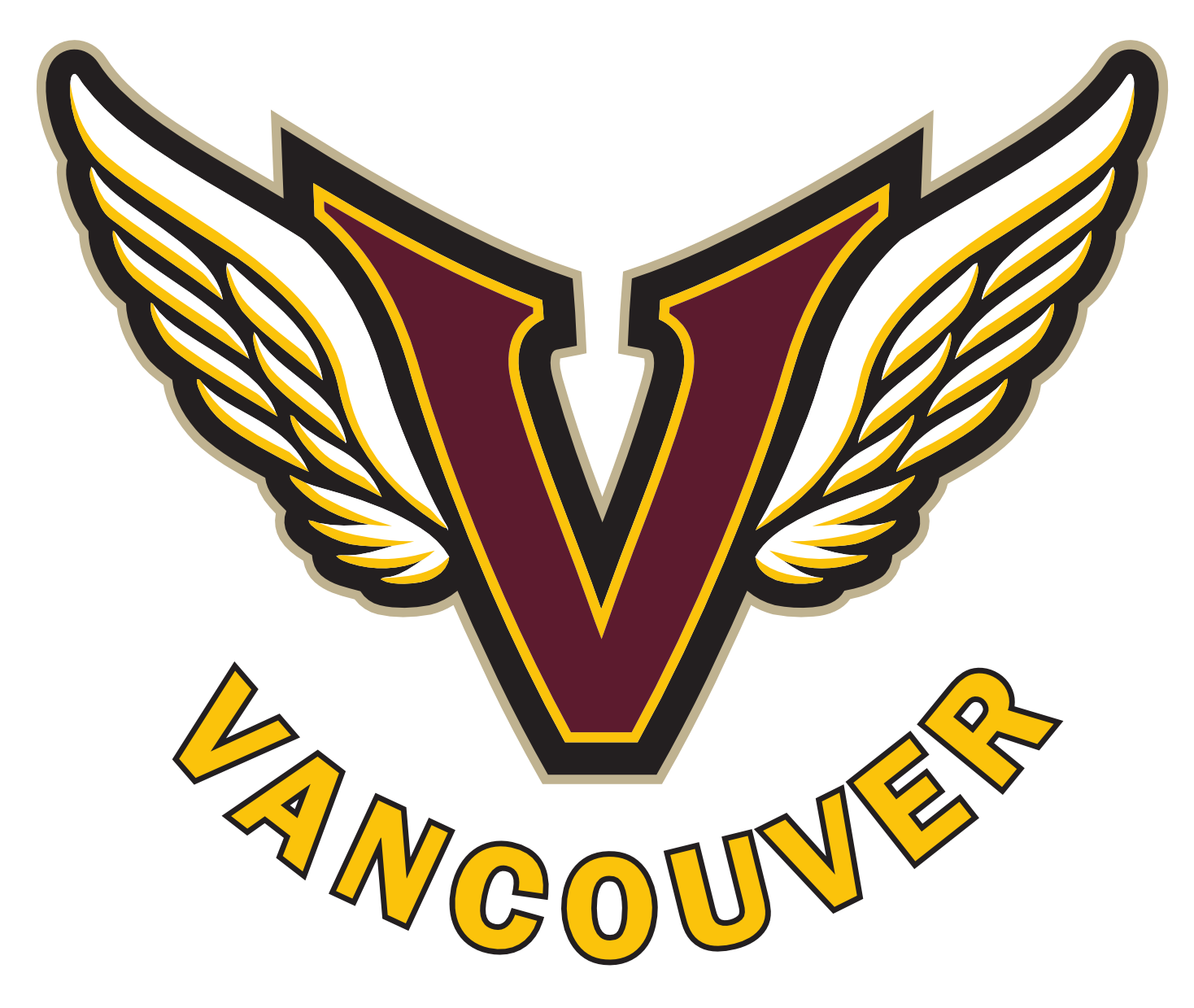Off-ice Officials: Timekeepers and Scorekeepers
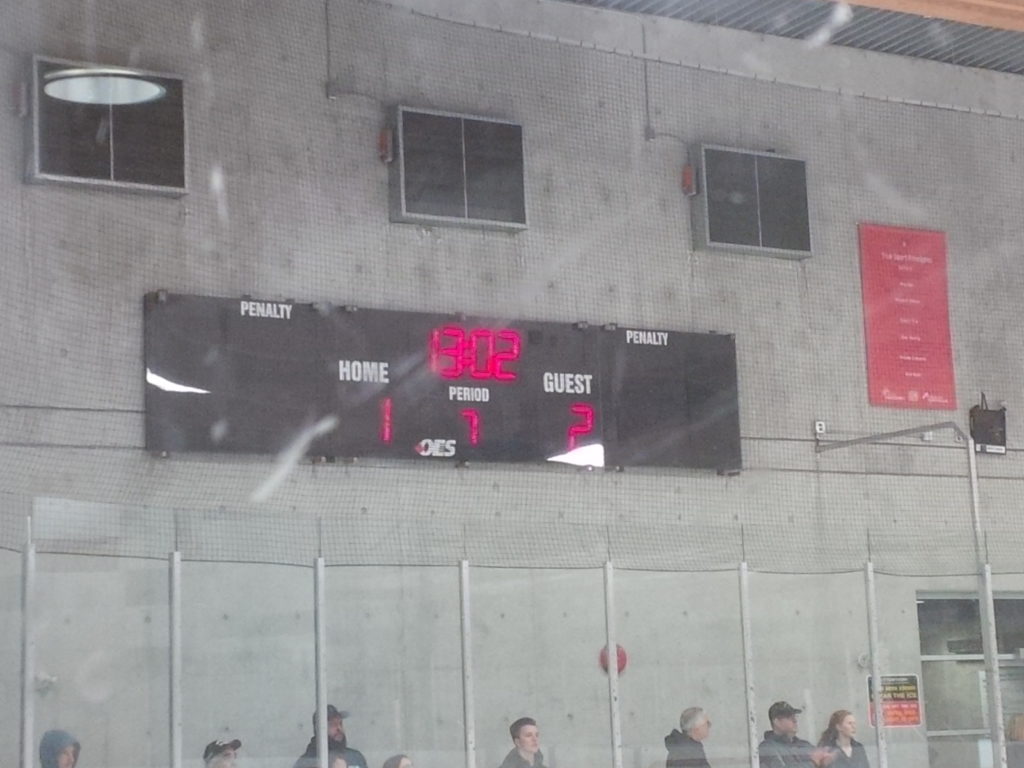
Due to the nature of how timekeepers and scorekeepers are generally selected from the parents of the home team, it could be assumed that these are team positions. In fact, the positions are Off-ice Officials who work under the direction of the Referee(s) of the game.
Your demeanor should be neutral, i.e. you shouldn’t be showing any favoritism towards either of the teams. You should not be offering your opinion to the referee about penalty calls or commenting on how they are managing the game.
Please be at your assigned game at least 15 minutes before the game in order to ensure that the clock is working properly and that you understand how to run it. Please practice entering the period number, period time, multiple penalties and adjusting the time.
Please note that it is your responsibility to open the gate to the penalty box for the penalized player to enter and to ensure she returns to play at the correct time. You must ensure that the gate(s) are securely closed.
The tasks of the time and score keepers is essential for the smooth running of the game. Understanding how the clock works and how goals and penalties are to be written on the gamesheet can save a lot of confusion and, often, a lot of time which could be used for playing the game. Here's some tips to make the job easier.
Timekeepers
If you are unfamiliar with how to use the rink's clock, try to find someone who has used it before to help you. Use the time before the game when the ice is being cleaned to practice putting the period number and time on the clock. Try entering penalties for each team. Try clearing a penalty (this would happen if a team was playing short-handed and they were scored against). See if you can reset the time on the clock and pay attention to what happens with any penalties shown.
Here’s some important points:
- Coincidental penalties (i.e. each team receives an equal number of penalties of the same length at the same stoppage of play). Typical coincidental penalties are Black team 1x minor tripping penalty (2 minutes) and White team 1x minor slashing penalty (2 minutes). NO TIME IS SHOWN ON THE CLOCK. And the players do not leave the penalty boxes until the first whistle after the expiration of their penalties (even if their team is scored against). So, if the penalties were called at 10:00 and they end at 8:00, they may leave the penalty boxes at the first whistle after 8:00. Why? Because their teams are playing 5 on 5 and if they leave the penalty boxes at 8:00 and play is in progress, each team will have too many players on the ice. Please note that in a different situation at the same stoppage of play if the Black team gets a major penalty (5 minutes) and the White team a minor penalty (2 minutes) these are not coincidental penalties and both will be shown on the clock.
- A team with more than 2 penalties. For example Black team get a minor penalty at 8:00, then another minor penalty at 7:20 and a third penalty at 7:00. Even though there are 3 penalties, the teams are not allowed to have less than 3 players on the ice. The clocks only show 2 penalties per team at a time, but the timekeeper needs to enter all three penalties and it is very important to enter the jersey number of each of the penalized players. The clock software will keep track of the 3 penalties. You will notice that on the clock console the 3rd penalty will not start to count down until the first penalty is finished. So, at 6:00 when the first penalty expires the third penalty will start counting down from 2 minutes. VERY IMPORTANT: The 1st penalized player cannot leave the penalty box at 6:00 because there are still 2 penalties showing on the clock. She must wait until the 2nd penalty expires at 5:20 when there will be then only one penalty on the clock and her team can then have 4 players on the ice. The 2nd penalized player may leave the penalty box at 4:00 when the third penalty expires. Because the Black team now has 5 players on the ice, the third penalized player will leave the penalty box at the first stoppage of play after 4:00.
- To make this as simple as possible, if there are 2 penalties on the clock there can only be 3 players on the ice and no one can leave the penalty box.
- Another twist to this is: Two players from the Black team get a minor penalty each at 10:00, then another Black team player gets a minor penalty at 9:30. The same process is used as above in that all the penalties are entered with the jersey numbers. The third penalty won’t start until 8:00 when the first two penalties expires, BUT at 8:00 only 1 of the two players penalized at 10:00 can go on the ice and who this is is determined by which penalty was reported by the referee first. So, at 10:00 you are not going to know there will be a third penalty coming but you need to make sure that on the game sheet you write the penalties in the order of when they were reported by the referee.
- Short-handed team scored against.
- If the player has a minor penalty, she returns to the ice and the penalty is cleared from the clock.
- If the team has 2 penalized players in the penalty box, it is the penalty with the least amount of time that has the player return to the ice and the penalty cleared from the clock.
- If there is a player with a coincidental penalty, she stays in the box. If there is another player serving a non-coincidental minor penalty, she can return to the ice and have her penalty cleared from the clock.
- If the player is serving a major penalty (5 minutes), she can only return to the ice after the 5 minutes assuming there aren’t any further penalties assessed.
- Major with Minor Penalties. The major penalty (5 minutes) is served first. The player serving the penalty (the actual penalized player is removed from the game) cannot leave the box if their team is scored against during the 5 minutes. When entering the time in the clock add the minor penalty(ies) to the 5 minutes. For example, major penalty + minor = 5:00 + 2:00 = 7:00. 7:00 should be shown on the clock.
- Adjusting the Time. It is important that the timekeeper is alert to the game in order to start and stop the clock. There may be times when the referee asks for the time to be adjusted. Please note that if there are penalties showing on the clock you will need to manually adjust the time of the penalties. For example, play stops at 15:55 and the referee asks that it be changed to 16:00. If there is a penalty which has 30 seconds left on it, you will need to manually change this to 35 seconds.
Scorekeepers
Referee Signals
It helps the flow of the game if the referee can show the signal for the penalty assigned to the player(s) entering the penalty box without having to speak with the Scorekeeper. If you don't understand the hand signal, make sure the referee sees so that you don't enter the wrong penalty on the game report which could have potential repercussions for a player, e.g. After 3 stick infractions a player is ejected from the game.
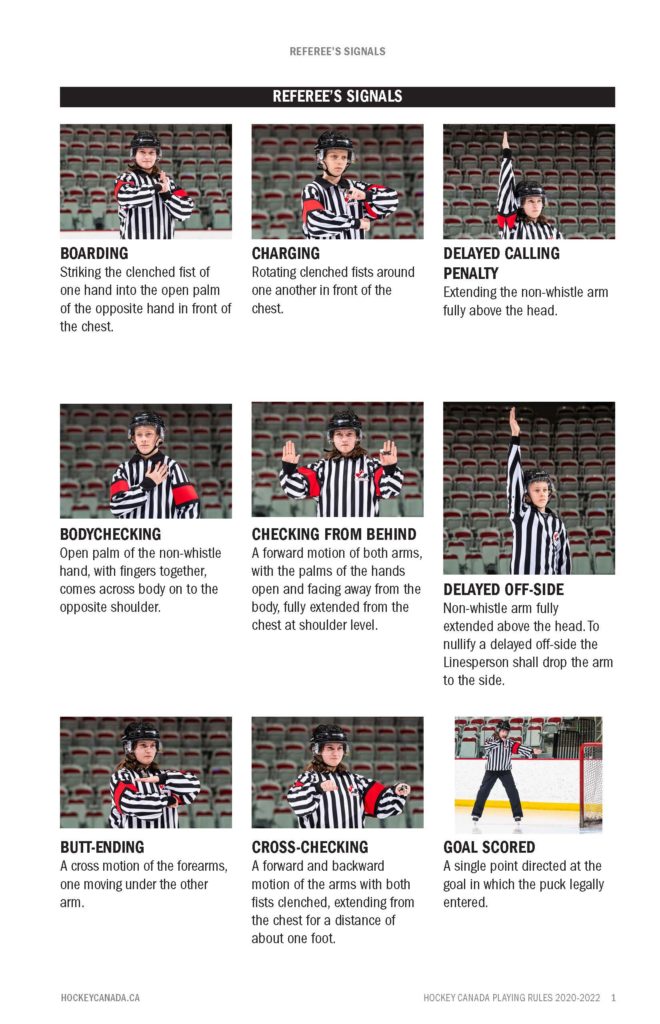
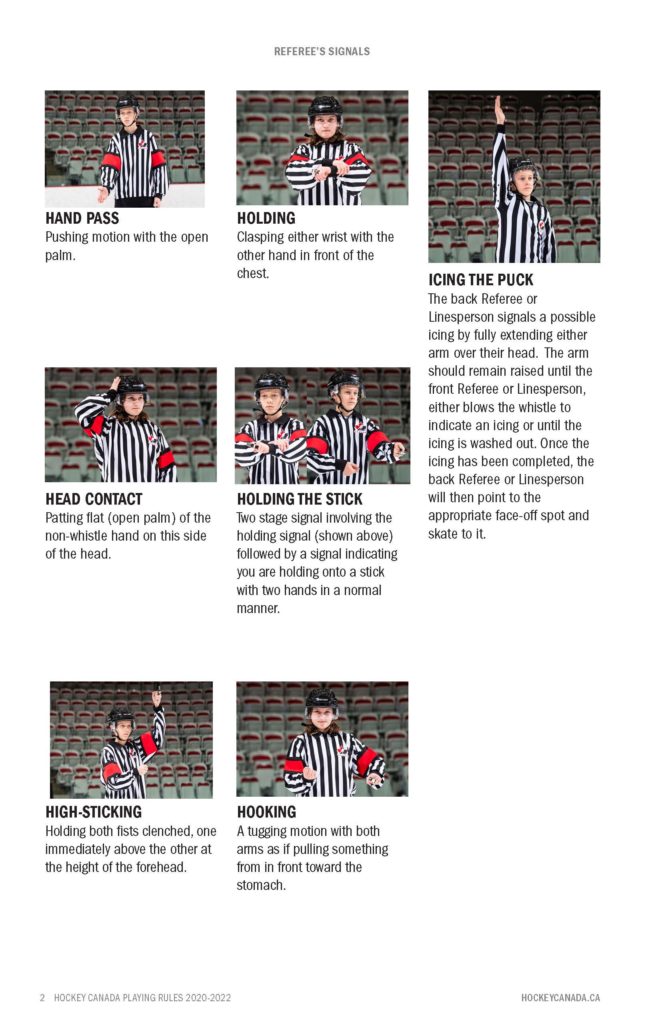
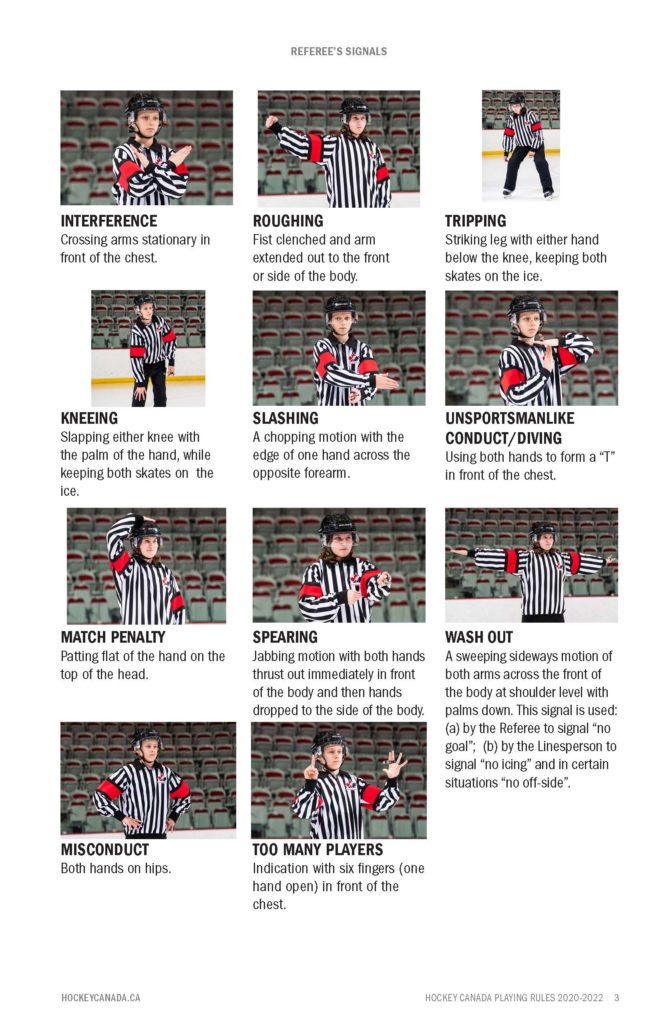
Game Report
The following sample game report gives examples how to enter most types of penalties. Please see below the game report the explanation.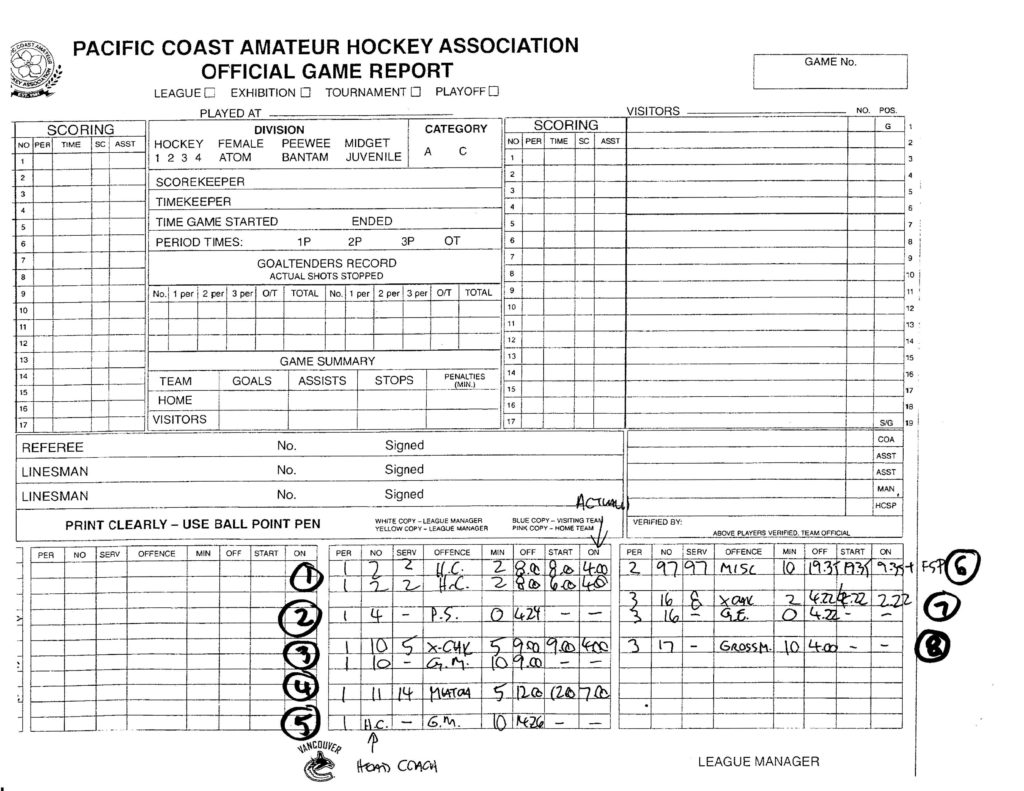
- Head Contact, double minor. The Head Contact penalty can be a minor, double minor or major. In the case of a double minor, although 4 minutes is shown on the clock, rather than showing 4 minutes on the game sheet, there should be two lines of minor penalties. Please note that if the penalized team is playing short-handed and are scored against, the first minor penalty will expire and the second minor penalty will start at the time of the goal.
- Penalty Shot. There’s no penalty served, but the penalty shot is shown with the penalized player’s number, P.S., 0 minutes at the time the game stopped.
- Major Penalty. The major penalty is shown first. Because it is a major penalty the player will be removed from the game and you will need to put both their jersey number and the number of the player serving the penalty. The time is 5 minutes and, as noted above, the serving player cannot leave the penalty box until it is fully served, i.e. she doesn’t return to the game if there is a goal scored against them. The next line is to show the Game Misconduct whose time is 10 minutes, but this is not served time nor put on the clock. If there is also a minor penalty against the same player, this is shown below the Game Misconduct (G.M.)
- Match Penalty. Player is removed from game and the serving player sits for 5 minutes and cannot leave the penalty box.
- Game Misconduct. In this situation the coach is getting kicked out of the game. No one sits for a timed penalty.
- Misconduct. No time on the clock. Player sits for the full 10 minutes and returns after the first stoppage of play (FSP) after 10 minutes.
- Game Ejection. This is for a player with 3 minor penalty stick infractions (CHESS: cross-checking, high-sticking, butt-ending, slashing, spearing). You can help the referee by tracking the penalties of the players and informing the referee if a player reaches the 3rd stick infraction.
- Gross Misconduct. The player is removed from the game. No one serves the penalty.
